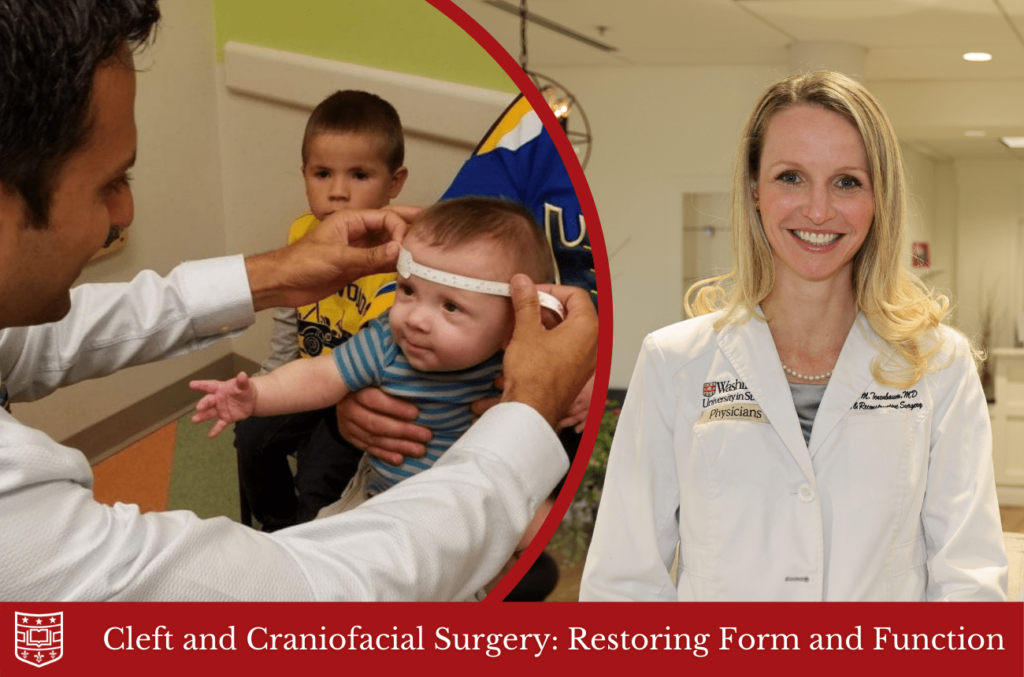Cleft and craniofacial differences are more common than some people may think. Cleft lip or cleft palate affects about one in every 700 children. Craniofacial disorders or differences are less common, affecting one to two of every 1,000 children born in the United States. Children born with these differences often have impaired language development and ability to feed. Other problems these children might encounter include increased risk for ear infections, hearing issues, and problems with their teeth. For these reasons, surgery is one of the best treatment options for patients with craniofacial differences.
Plastic and reconstructive surgeon Alison Snyder-Warwick, MD, assistant professor of surgery in the Division of Plastic and Reconstructive Surgery and co-director of the Cleft Palate and Craniofacial Institute at St. Louis Children’s Hospital, has dedicated much of her career to restoring form and function of children with cleft and craniofacial differences.
“The goal of management by our multidisciplinary team is to allow children to reach their maximum potential,” Snyder-Warwick says. “We are here to support children throughout their development, sometimes from the prenatal period all the way through physical maturity.”
Since its inception in 1978, the Cleft Palate and Craniofacial Institute team has treated more than 4,000 patients with cleft lip and cleft palate, in addition to another 2,800 with major craniofacial differences. The institute offers comprehensive evaluation, diagnosis and treatment for congenital (noticed at birth) and acquired neck and head injuries.
Co-directors Snyder-Warwick and Kamlesh Patel, MD, lead the multidisciplinary team to provide each child the best chance for a positive self-image, an attractive appearance, intact hearing, understandable speech, useful vision, and healthy teeth—allowing a smooth progression through childhood and adolescence and into adulthood.
Once a patient’s condition is diagnosed, Snyder-Warwick’s team gets to work identifying the best course of treatment. The Team tracks weight gain closely, and for a child who is born with cleft lip and palate, for example, presurgical treatment such as lip taping or naso-alveolar molding therapy is pursued. Lip and nose repair surgery is performed between three and six months after birth.
“At different points in a child’s growth and development, different concerns may arise. Members of our team provide the expertise necessary to anticipate, identify and manage any developments appropriately and provide care throughout all stages of childhood.”
The team will continue to meet with the patient, annually if needed, to track growth, speech, hearing, emotional and cognitive development, perform additional repair surgeries, and determine the next steps in the patient’s journey.
Common cleft and craniofacial differences
Cleft lip
Opening or split in the upper lip that occurs when developing facial structures in an unborn baby do not close completely
Cleft palate
The tissue that makes up the roof of the mouth do not join together completely during pregnancy
Craniosynostosis
The bones in a baby’s skull join together too early before their brain is fully formed
Hemifacial microsomia
The tissues on one side of the face (the ear, mouth and jaw) are underdeveloped
Vascular malformation
Birthmark or growth composed of blood vessels that may cause functional or aesthetic problems
Plagiocephaly
A flat spot develops on the back or side of an infant’s head
“I am fortunate to be able to work with the brave, strong and inspiring children at the Cleft Palate and Craniofacial Institute,” Snyder-Warwick says. “Children have the best attitudes when facing challenges, and I learn a lot about life from them.”
The pediatric plastic surgeons in the Division of Plastic and Reconstructive Surgery are committed to providing comprehensive and effective patient care to even the youngest patients. To schedule an appointment with a pediatric plastic surgeon, call 314-362-7388 or request an appointment online.
